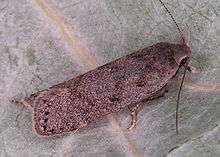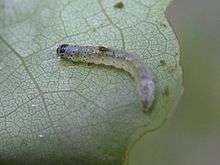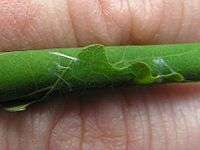Anacampsis populella
Anacampsis populella is a moth of the family Gelechiidae, which is native to Europe and has been accidentally introduced to North America. It was first described in 1759 by Carl Alexander Clerck, a Swedish entomologist. The type specimen is from Sweden. The foodplants of the larvae are poplars (Populus species) and willows (Salix species).
| Anacampsis populella | |
|---|---|
 | |
 | |
| Scientific classification | |
| Kingdom: | |
| Phylum: | |
| Class: | |
| Order: | |
| Family: | |
| Genus: | |
| Species: | A. populella |
| Binomial name | |
| Anacampsis populella | |
| Synonyms | |
| |
Life cycle
The wingspan is 14–19 mm, the colours are variable and the sexes are similar. They are on wing from June to September, depending on the location, and can be found on tree trunks, dislodged from foliage or swept from creeping willow (Salix repens). They also come to light. A similar species, A. blattariella is also a variable species and can only be told apart from A. populella by genitalia dissection.[2][3]
Ovum
Eggs are laid on various species of poplar including aspen (Populus tremula) and willows, such as goat willow (Salix caprea) and white willow (Salix alba).[2]
Larva

Larvae can be found from mid-April to June. The head and divided prothoracic plate are black and the body is greyish green with round black pinacula which are easily seen, while the anal plate is brownish. The larva rolls a leaf into a tube, held together with silken strands which can be seen on the edges of the roll. On creeping willow, due to their small size several leaves are spun around the central shoot, starting a short distance below the tip and working upwards.[2][3] Larvae of A. temerella also roll leaves around creeping willow.[4]
Pupa
Pupation takes place in a cocoon within a rolled leaf of the foodplant.[2]
Distribution
The moth is found in most of Europe and has been accidentally introduced to North America.[2]
References
- "Anacampsis populella (Clerck, 1759)". PESI portal. Retrieved 21 December 2018.
- Emmet, A Maitland; Langmaid, John R; Bland, K P; Fletcher, D S; Harley, B H; Robinson, G S; Skinner, Bernard; Tremewan, W G, eds. (2002). The Moths and Butterflies of Great Britain and Ireland. Volume 4, Part 2. Colchester: Harley Books. pp. 217–18. ISBN 0 946589 66 6.
- "35.011 Anacampsis populella (Clerck, 1759)". Gelechiid Recording Scheme. Retrieved 21 December 2018.
- "35.013 Anacampsis temerella (Lienig & Zeller, 1846)". Gelechiid Recording Scheme. Retrieved 21 December 2018.
External links
![]()